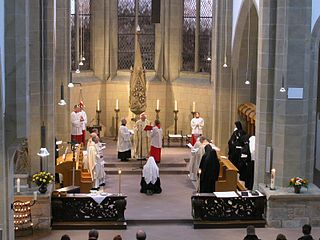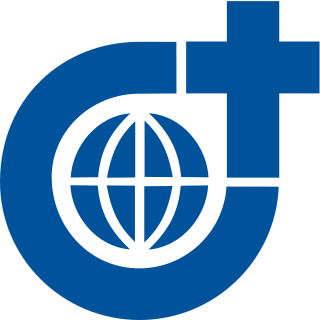
The Society of Jesus abbreviated SJ, also known as the Jesuits, is a religious order of clerics regular of pontifical right for men in the Catholic Church headquartered in Rome. It was founded in 1540 by Ignatius of Loyola and six companions, with the approval of Pope Paul III. The society is engaged in evangelization and apostolic ministry in 112 nations. Jesuits work in education, research, and cultural pursuits. Jesuits also give retreats, minister in hospitals and parishes, sponsor direct social and humanitarian ministries, and promote ecumenical dialogue.

A monk is a person who practices religious asceticism by monastic living, either alone or with any number of other monks. A monk may be a person who decides to dedicate their life to serving other people and serving God, or to be an ascetic who voluntarily chooses to leave mainstream society and live their life in prayer and contemplation. The concept is ancient and can be seen in many religions and in philosophy.
A solemn vow is a certain vow taken by an individual during or after novitiate in a Catholic religious institute. It is solemn insofar as the Church recognizes it as such.

Religious vows are the public vows made by the members of religious communities pertaining to their conduct, practices, and views.

The Society of the Divine Word, abbreviated SVD and popularly called the Verbites or the Divine Word Missionaries, and sometimes the Steyler Missionaries, is a Catholic clerical religious congregation of Pontifical Right for men. As of 2020, it consisted of 5,965 members composed of priests and religious brothers working in more than 70 countries, now part of VITA international. It is one of the largest missionary congregations in the Catholic Church. Its members add the nominal letters SVD after their names to indicate membership in the Congregation. The superior general is Paulus Budi Kleden who hails from Indonesia.
The Missionaries of the Sacred Heart of Jesus are a missionary congregation in the Catholic Church. It was founded in 1854 by Servant of God Jules Chevalier (1824–1907) at Issoudun, France, in the Diocese of Bourges.
The Missionaries of Our Lady of La Salette are a religious congregation of priests and brothers in the Latin Church. They are named after the apparition of Our Lady of La Salette in France. There is also a parallel religious community of sisters called the Missionary Sisters of Our Lady of La Salette. A lay fraternal group of associates also works in cooperation with the vowed religious. The Missionaries are dedicated to making known the message of Our Lady of La Salette, a call to healing of inner brokenness and personal reconciliation with God, especially as found in the first three commandments. The missionaries are popularly known as "the La Salettes."

The sacrament of holy orders in the Catholic Church includes three orders: bishops, priests, and deacons, in decreasing order of rank, collectively comprising the clergy. In the phrase "holy orders", the word "holy" means "set apart for a sacred purpose". The word "order" designates an established civil body or corporation with a hierarchy, and ordination means legal incorporation into an order. In context, therefore, a group with a hierarchical structure that is set apart for ministry in the Church.

The Congregation of St. Cecilia, commonly known as the Nashville Dominicans, is a religious institute of the Roman Catholic Church located in Nashville, Tennessee. It is a member of the Council of Major Superiors of Women Religious, one of the two organizations which represent women religious in the United States. The sisters combine a monastic communal lifestyle of contemplation in the Dominican tradition with an active apostolate in Catholic education. As of 2018, the congregation has 300 sisters.
In the canon law of the Catholic Church, an impediment is a legal obstacle that prevents a sacrament from being performed either validly or licitly or both. The term is used most frequently in relationship to the sacraments of Marriage and Holy Orders. Some canonical impediments can be dispensed by the competent authority as defined in Catholic canon law.

The priesthood is the office of the ministers of religion, who have been commissioned ("ordained") with the Holy orders of the Catholic Church. Technically, bishops are a priestly order as well; however, in layman's terms priest refers only to presbyters and pastors. The church's doctrine also sometimes refers to all baptised (lay) members as the "common priesthood", which can be confused with the ministerial priesthood of the consecrated clergy.
Clerical celibacy is the discipline within the Catholic Church by which only unmarried men are ordained to the episcopate, to the priesthood in some autonomous particular Churches, and similarly to the diaconate. In other autonomous particular churches, the discipline applies only to the episcopate.
Vocational discernment is the process in which men or women in the Catholic Church discern, or recognize, their vocation in the church. The vocations are the life as layman in the world, either married or single, the ordained life and the consecrated life.

Lorenzo Maria of Saint Francis Xavier – born Lorenzo Salvi – was an Italian Roman Catholic priest and a professed member of the Passionists. Salvi became friends with Gaspar del Bufalo and Bartolomeo Alberto Cappellari – future pope – during the course of his studies prior to his ordination. He was forced out of the Passionist house due to anti-clerical laws from Napoleon Bonaparte but later returned when safe to do so in order to preach and spread the charism of the Child Jesus.

The Missionaries of the Company of Mary is a missionary religious congregation within the Catholic Church. The community was founded by Saint Louis de Montfort in 1705 with the recruitment of his first missionary disciple, Mathurin Rangeard. The congregation is made up of priests and brothers who serve both in the native lands and in other countries. The Montfortian Family comprises three groups: the Company of Mary, the Daughters of Wisdom and the Brothers of Saint Gabriel.
Ascendente Domino was a papal bull issued by Pope Gregory XIII, 24 May 1584, in favor of the Society of Jesus, to confirm the constitution of the Society, and the privileges already granted to it by Paul III, Julius III, Paul IV, and Pius V.
A religious brother is a member of a Christian religious institute or religious order who commits himself to following Christ in consecrated life of the Church, usually by the vows of poverty, chastity and obedience. He is a layman, in the sense of not being ordained as a deacon or priest, and usually lives in a religious community and works in a ministry appropriate to his capabilities.
A religious institute is a type of institute of consecrated life in the Catholic Church whose members take religious vows and lead a life in community with fellow members. Religious institutes are one of the two types of institutes of consecrated life; the other is that of the secular institute, where its members are "living in the world".

The Society of Our Lady of the Most Holy Trinity (SOLT) is a Society of Apostolic Life within the Roman Catholic Church. It was founded in 1958 by Father James H. Flanagan, a priest from the United States. The Society maintains missions in various countries, describing itself as Marian-Trinitarian, Catholic, missionary, and family. Membership in the Society includes priests, permanent deacons, religious sisters, religious brothers, and the lay faithful.
Giuseppe Antonio Migliavacca – in religious Arsenio da Trigolo – was an Italian Roman Catholic priest and a professed member from the Order of Friars Minor Capuchin. He had been a Jesuit for a period of time before he was forced to withdraw from the order due to a series of complications. Migliavacca founded the Suore di Maria Santissima Consolatrice in 1892 alongside a small group of women who desired to become nuns, but slanderous accusations made against him forced him to abandon it and pursue the Franciscan charism instead; he dealt with these humiliations in private but once a Franciscan became a preacher and confessor and aided the tertiaries of the Third Order of Saint Francis in Bergamo.











